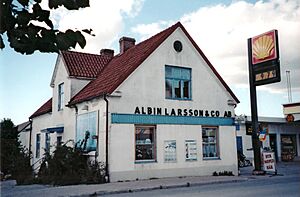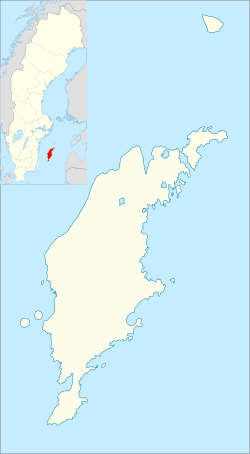Hemse facts for kids
Quick facts for kids
Hemse
|
|
|---|---|

Hemse main street
|
|
| Country | Sweden |
| Province | Gotland |
| County | Gotland County |
| Municipality | Gotland Municipality |
| Area | |
| • Total | 2.11 km2 (0.81 sq mi) |
| Population
(31 December 2014)
|
|
| • Total | 1,700 |
| • Density | 814/km2 (2,110/sq mi) |
| Time zone | UTC+1 (CET) |
| • Summer (DST) | UTC+2 (CEST) |
Hemse is a cool town located on the Swedish island of Gotland. In 2014, about 1,700 people lived there. It's the second largest place on the island, right after Visby. Hemse is the main hub for people living in the southern part of Gotland. It's also famous for its lively markets!
Hemse is also the name of a larger area, called a socken (which is like a traditional district). This area is the same as the administrative Hemse District, which started on January 1, 2016.
Where is Hemse Located?
Hemse is a town built around the old medieval Hemse Church. Sometimes, people call this area Hemse kyrkby, meaning "Hemse church village." It's right in the middle of southern Gotland. As of 2019, Hemse Church is part of a larger church group called Alva-Hemse-Rone parish. This group also includes churches in Alva and Rone.
Did you know that an asteroid in space is named after Hemse? It's called 10124 Hemse! This asteroid is part of the main asteroid belt between Mars and Jupiter.
Hemse's Past
Something really special was found under the floor of Hemse Church in the late 1800s. It was parts of the Hemse stave church. This is the best-preserved example of a stave church ever found in modern-day Sweden! Stave churches are old wooden churches built with a special technique.
Fun Events in Hemse
One of the biggest events each year is the Hemse Market. It's a huge autumn market on Gotland! There are five main markets held on the island between August and October. These include markets in Slite, Havdhem, Kräklingbo, Klintehamn, and of course, Hemse. Each market usually lasts for a whole weekend.
Sports in Hemse
If you love sports, Hemse has its own local club.
- Fardhem IF
Hemse's Weather
Hemse has a maritime climate, which means its weather is influenced by the sea. But because it's a bit inland on Gotland, it also has some weather features like mainland southern Sweden. This means Hemse has some of the warmest summer days and coldest winter nights compared to other weather stations on Gotland. It also gets more rain and snow than the coastal areas.
Even with these differences, the seasons change slowly. This means spring can still have some chilly days. Gotland's coast is one of the sunniest places in the Nordic and Baltic regions. So, even inland in Hemse, you often get clear nights. This leads to big changes between day and night temperatures, which is quite unique for a Swedish coastal area.
| Climate data for Hemse (2002–2020 averages, extremes since 1945) | |||||||||||||
|---|---|---|---|---|---|---|---|---|---|---|---|---|---|
| Month | Jan | Feb | Mar | Apr | May | Jun | Jul | Aug | Sep | Oct | Nov | Dec | Year |
| Record high °C (°F) | 8.5 (47.3) |
12.1 (53.8) |
17.9 (64.2) |
25.4 (77.7) |
28.7 (83.7) |
30.9 (87.6) |
33.7 (92.7) |
35.0 (95.0) |
29.0 (84.2) |
21.0 (69.8) |
14.6 (58.3) |
10.2 (50.4) |
35.0 (95.0) |
| Mean maximum °C (°F) | 6.1 (43.0) |
7.2 (45.0) |
12.6 (54.7) |
18.5 (65.3) |
23.6 (74.5) |
26.2 (79.2) |
28.2 (82.8) |
27.4 (81.3) |
22.6 (72.7) |
16.9 (62.4) |
11.7 (53.1) |
7.6 (45.7) |
29.4 (84.9) |
| Mean daily maximum °C (°F) | 1.8 (35.2) |
2.3 (36.1) |
5.5 (41.9) |
11.3 (52.3) |
16.5 (61.7) |
20.4 (68.7) |
22.7 (72.9) |
22.1 (71.8) |
17.7 (63.9) |
11.4 (52.5) |
6.9 (44.4) |
3.7 (38.7) |
11.9 (53.3) |
| Daily mean °C (°F) | −0.6 (30.9) |
−0.4 (31.3) |
1.5 (34.7) |
5.9 (42.6) |
10.7 (51.3) |
14.8 (58.6) |
17.6 (63.7) |
17.0 (62.6) |
13.1 (55.6) |
7.9 (46.2) |
4.5 (40.1) |
1.6 (34.9) |
7.8 (46.0) |
| Mean daily minimum °C (°F) | −3.0 (26.6) |
−3.0 (26.6) |
−2.6 (27.3) |
0.5 (32.9) |
4.8 (40.6) |
9.1 (48.4) |
12.4 (54.3) |
11.9 (53.4) |
8.5 (47.3) |
4.3 (39.7) |
2.1 (35.8) |
−0.6 (30.9) |
3.7 (38.7) |
| Mean minimum °C (°F) | −13.6 (7.5) |
−11.9 (10.6) |
−11.1 (12.0) |
−5.9 (21.4) |
−2.4 (27.7) |
2.0 (35.6) |
6.7 (44.1) |
4.9 (40.8) |
1.1 (34.0) |
−3.3 (26.1) |
−5.8 (21.6) |
−8.6 (16.5) |
−15.8 (3.6) |
| Record low °C (°F) | −24.8 (−12.6) |
−25.7 (−14.3) |
−22.6 (−8.7) |
−10.8 (12.6) |
−7.0 (19.4) |
−1.4 (29.5) |
2.8 (37.0) |
0.3 (32.5) |
−6.8 (19.8) |
−9.4 (15.1) |
−15.1 (4.8) |
−22.0 (−7.6) |
−25.7 (−14.3) |
| Average precipitation mm (inches) | 55.6 (2.19) |
40.2 (1.58) |
34.2 (1.35) |
24.5 (0.96) |
25.7 (1.01) |
40.6 (1.60) |
72.2 (2.84) |
70.8 (2.79) |
48.2 (1.90) |
61.8 (2.43) |
68.4 (2.69) |
66.6 (2.62) |
608.8 (23.96) |
| Source 1: SMHI | |||||||||||||
| Source 2: SMHI | |||||||||||||


